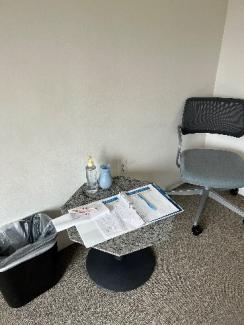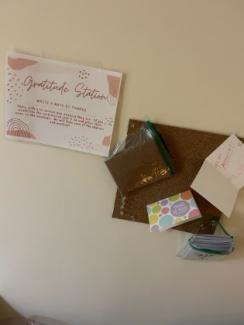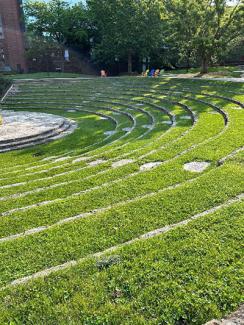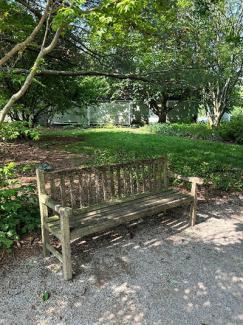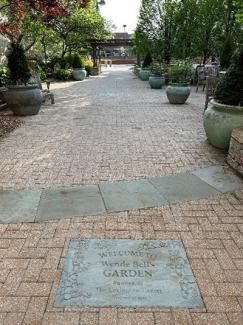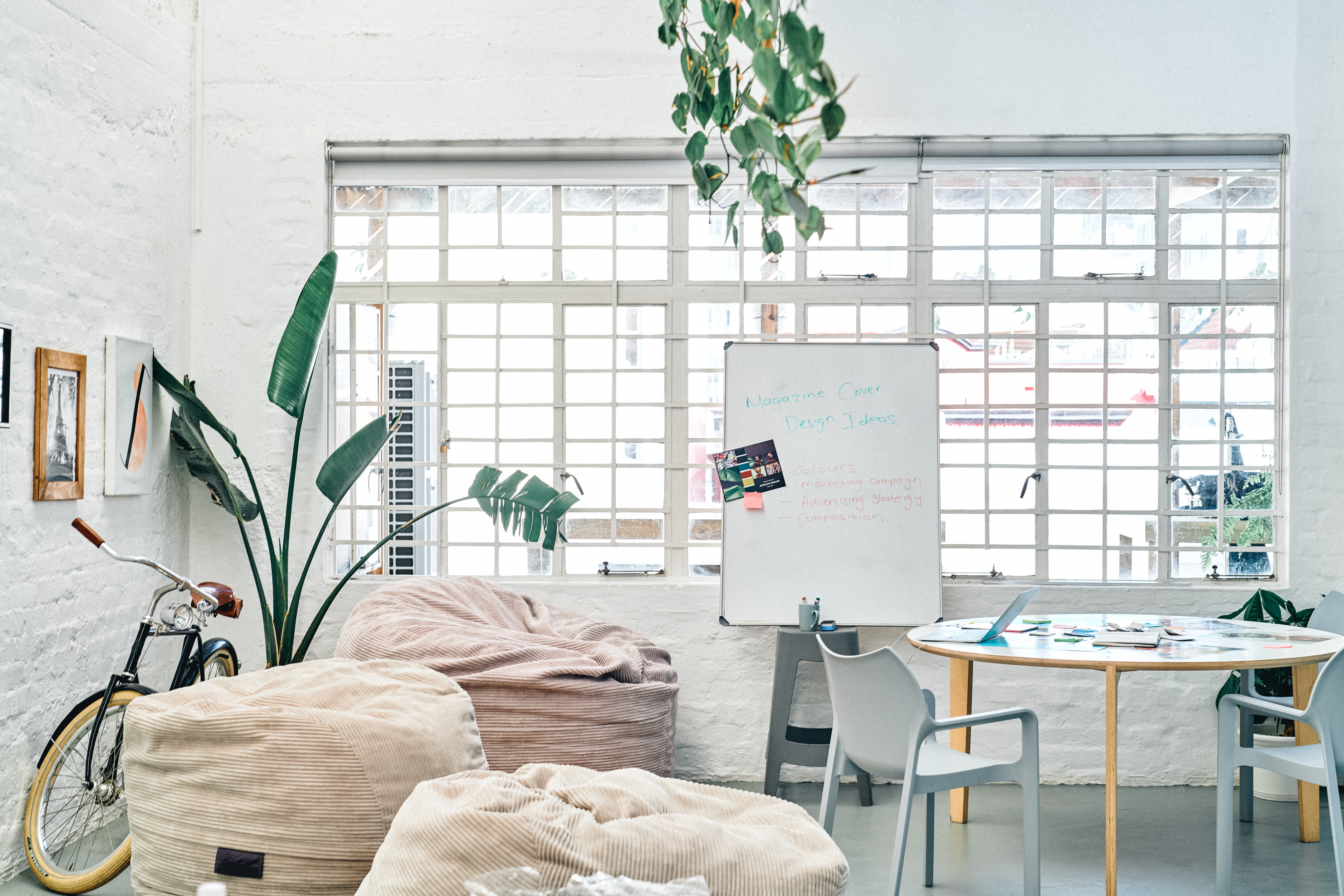
Chronic stress can often feel inescapable – it can affect our minds, bodies, performance and relationships. It ultimately leaves us feeling less than our best. But, here’s the good news! Research suggests that when we intentionally look for ways to reduce stress in our environments, it can positively impact our daily lives.
Calming spaces are great tools for supporting mental and emotional well-being in the workplace. These dedicated spaces provide opportunities to slow down, recharge and decompress. They can decrease stress and improve focus. One study found that calming spaces at work can reduce stress by 60% after just 15 minutes. Calming spaces at work may also help:
- decrease rates of burnout
- improve mental health
- foster resilience
- lessen anxiety
- strengthen immune systems
- improve resting heart rate and lower blood pressure
- restore cognitive function lost to trauma
Create a shared calming space in your college, department or area.
To create a calming environment, researchers suggest incorporating multiple senses. When you do, you can
become more attached to a moment, an object or a space. Then, your brain and nervous systems are able to deal with difficult emotions and stimulate your body’s calm response.
Soft lighting, soothing colors and comfortable furniture are a great start to designing a calming shared space. People also have the drive to connect with nature, which can inspire your space and improve your well-being. Here are some ways to tap into the calming features of nature and your senses:
Sight
Exposure to photos or virtual environments that incorporate nature can lower stress by decreasing blood pressure and heart rate. Even simply bringing a plant into a windowless area has soothing benefits.
Sound
Brain imaging shows that nature sounds and calming music stimulate areas of the brain that calm emotions, decrease pain and lower heart rate and blood pressure. Even a short break (under 7 minutes) of listening to nature sounds can reduce muscle tension, pulse rate and stress.
Touch
Calming touch can make you feel safe as it soothes your stress and helps you relax. Basic warm touch calms cardiovascular stress and activates the body’s vagus nerve. This can release a soothing hormone called oxytocin. Bringing elements of nature indoors to touch and experience, even for a short time, can reduce stress.
Smell
Aromatherapy, specifically lavender, can improve your mood, lessen anxiety and calm your nervous system. The scents released by essential oils interact with the brain and positively affect your mood, reduce your stress response, lower anxiety and deepen sleep.
Step-by-step guide
Ready to explore adding a shared calming space in your area?
You and your team can use the following guide to create a calming space tailored to the unique needs and circumstances of your college, department or unit. This worksheet may help you to create a proposal.
If you have questions or need additional guidance to create your shared calming space, reach out to us for a consult.
Step 1: Choose your space and experience
The first step in creating a calming space is to match your space to your desired experience. Multiple factors will influence each.
You can determine the location and size of the space you have available by considering these questions:
- What rooms or areas are currently available?
- Will the proposed calming space be private, semi-private or in the open?
- Do you need a portable kit for creating pop-up calming spaces or something that individuals could borrow for their office space?
Once you have chosen your space, you can match the activities and overall experience to what you have available. If you have multiple spaces available, this can help you decide which to choose. If you are unable to locate a space, contact us!
Consider the following:
- Will it be a quiet place for activities like meditation, reflection or yoga?
- Do you want to include technology, like a calm video? Or do you want a space for activities like reading, writing or coloring?
- Which sensory elements are most important to incorporate?
- How do you want people to feel when they spend time in this space?
Knowing the purpose of your space will help guide your budget, design and visuals in the space.
Step 2: Determine your budget
When choosing a budget for your department, it’s important to consider how much is necessary and available for this project. You want to be sure you focus on the essentials for your space to contribute to the overall calming experience. Here are a couple of questions to consider:
- What can you realistically afford? Look at your department’s budget and see what you can comfortably spend. Match your budget to the space and desired experience. You can also consider where you might be able to reuse or repurpose items to save money.
- Will you need to break the budget up across multiple fiscal years? You might not have the funds for the perfect space right now, which is OK. It can be an evolving space, so focus on progress over perfection.
Creating a calming space doesn’t have to be expensive. Prioritize your spending on elements that will most impact the calm experience you want. With creativity and resourcefulness, you can create a peaceful environment that promotes relaxation and well-being without a financial burden.
Step 3: Choose your items
Research on calm spaces emphasizes the importance of the senses, so consider how you can incorporate multiple senses into the space. For example, you could choose items such as essential oils for smell, a noise machine for sound, battery-powered candles for sight or accessories like soft blankets and cushions for touch.
As you begin the process of choosing items to include in your calming space, here are some things to consider:
- How do you want the space to feel – energizing, invigorating, calming, restful, soothing, refreshing? For example, you can provide a desk for reading and writing if you want to allow for more creativity. If rest is the focus, incorporate comfortable cushions and soothing items.
- What can you fit in your space? Some items may not work in your available space. For example, meditation cushions may not be appropriate for a higher-traffic open area.
- Who are the stakeholders that need to be involved in this process? You’ll want to purchase items that add value and meaning to the space. Gather input and feedback from your colleagues, leadership and building managers.
Choose items that include as many senses as possible. If you need ideas for purchasing items, click here for a few ideas. These lists might spark creativity in your design process and help you determine a budget.
| Sense | Suggested Item | Notes and considerations |
|---|---|---|
| Sight | Silk/artificial plants and natural elements | Plants arranged in a semi-circle pattern can create the impression of being immersed in and surrounded by nature. Using natural materials like wood, stone or plants can bring a sense of warmth and comfort to a calming environment. |
| Sight | Soothing lighting | Use soft lighting whenever possible. Floor and table lamps, dimmable bulbs, flameless candles and similar items help create a soothing ambiance. |
| Sight | Projector | Display a peaceful environment using a blank wall or screen. |
| Smell | Essential oils | Aromatherapy reduces stress and increases relaxation when inhaling lavender essential oil. Essential oils can be distributed via a cool mist diffuser or simply placing the lavender oil directly on a cotton ball and inhaling the soothing aroma. |
| Sound | Tabletop fountain | |
| Sound | Speakers or sound machine | Create a soothing ambiance via nature soundscapes or restful instrumental music. |
| Taste | Tea/chocolate/mints | |
| Touch | Carpet or rugs | Offer a soft, calming texture while also aiding in soundproofing the space. |
| Touch | Comfortable seating | Chairs, massage cushions, recliners and similar items foster relaxation and comfort. |
| Touch | Assorted sensory items | Some items, like blankets, eye masks, finger labyrinths, adult coloring books and colored pencil sets, encourage our sense of touch. Sensory stickers, LEGOs, stacking rocks and soothing meditation card decks are other possibilities. |
Having a clear vision for your space, the experience you want to create and your available budget can help keep you on track as you plan your items. So, use steps one and two to inform your wish list.
Step 4: Submit a proposal
You and your team are ready to submit your proposal to the appropriate person or group.
Several key decision-makers may need to approve the plan before moving forward. These may include:
- College or department leadership. It is vital to communicate the potential benefits of a calming space, such as increased productivity and employee well-being. Providing a plan and possible costs for the space can be useful.
- Facilities Management. The facilities team and building administrator are often responsible for the physical aspects of your building. They may need to approve the proposal to ensure the calming space can be safely and efficiently integrated into the existing space.
- Other employees. An informal discussion during a team meeting or a survey can ensure that the proposed changes meet their needs.
Step 5: Procure your items
Once your plan is approved, you can purchase your items. There are several things to consider before purchasing your items:
- UK-approved vendors. The university provides a list of approved vendors. You can work with your business officer or other authorized departmental staff to search for and purchase your items.
- Purchasing procedures. Certain goods and services must be purchased in a specific manner. Your business officer or other authorized departmental staff can help you with this as well.
- UK Surplus. UK Surplus Property receives numerous items and supplies from departments. These items are made available on a first-come, first-served basis. This is a great way to reduce waste and save on your budget!
This is a good time to begin preparing your space by cleaning the area and recycling or sending items to surplus that are longer needed.
Step 6: Set up and maintain your calming space
As you receive your items, there are additional things to consider as you set up and maintain your calming space:
- Facilities Management. As in step 4, you may need to work with Facilities Management or your building administrator to prepare your space or install items.
- Promotion. How will you communicate your new calming space? Email, Teams chats, word-of-mouth, flyers or announcements during meetings are good strategies. If you have a communications specialist in your college or department, seek additional help.
- Usage procedures. Who will be allowed access to the space? When will the space be available for use? What process will be used for reserving or using the space, if any? These are important items to consider as you begin using the space. You could print guidelines or procedures to post in the room.
- Maintenance. Who will maintain or clean the space? Will items need to be restocked, and who will check? Consider designating a colleague or colleagues to perform routine checks and maintenance requests.
Need additional help? Reach out to us for a consult. And, please share your finished space with us! We'd love to see what your team creates.
Current locations
College of Agriculture - North
The College of Agriculture offers programs for nutrition, therapy, and therapy dogs They clean the room daily, and it can be used by students or employees to use as a resting place. It is not open to the public.
McVey Hall
76 McVey Hall, a study room for students with a locked door
Part of the CARES program room for students and employees
UK Counseling Center
The counseling center has many calming tools on our list, even massage chairs and light therapy! Open to students only.
WT Young Library 2-44 Meditation Room
This room is open to anyone in the library.
Good Samaritan Chapel
For a quiet place to pray or meditate, a sanctuary is open 24 hours a day, seven days a week. The sanctuary is on the first floor of the hospital next to Conference Room A. Visitors of all faiths are welcome to visit for worship services, prayer or quiet reflection.
Kentucky Children’s Hospital PICU
PICU Peace Room is a lactation and relaxation room for PICU employees, not for public use. It has a keypad on the door to access.
UK HealthCare Chapel and Meditation Room
The chapel and meditation room in UK Chandler Hospital for employee or public use
Outdoor - Amphitheatre by Memorial Hall
Outdoor - Arboretum
Outdoor - Area outside Johnson Center and Lancaster Aquatic Center
Outdoor - Breckinridge Courtyard
Outdoor - Cancer Center Garden
Outdoor - Dentistry Courtyard
Outdoor - Mathews Garden
Outdoor - President’s Garden and Pond
Health and Wellness
Do you have questions or need additional guidance to create your shared calming space? We are happy to help! Reach out to us for a calming space consult.
We also invite you to share your finished space with us. We would love to see what your team created and might even feature your space on this page.
Contact our office
Monday through Friday, 7:30 a.m. to 4 p.m.
(859) 257-9355
healthandwellness@uky.edu
Lancaster Aquatic Center Room 170






